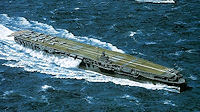 Concluding part of our series on Japanese aircraft carrier operations in early WWII
Concluding part of our series on Japanese aircraft carrier operations in early WWII
By John Dudek @ The Wargamer
The small Japanese naval task force sailed sedately along on this sunny 24 August 1942 morning, a hundred miles off the northerly coast of Guadalcanal, with the light carrier RYUJO escorted by a heavy cruiser and two destroyers. It was a near picture perfect South Pacific day and all was serene until the sudden and unexpected arrival of an airstrike of 30 American Dauntless dive bombers and 8 TBF Avenger torpedo planes from the US aircraft carrier SARATOGA. Four bomb hits, and at least one torpedo ripped into RYUJO knocking out the ship’s boiler room, leaving her dead in the water with an ever growing list to starboard. An escorting destroyer removed most of her crew but 133 men and officers were lost as the ship capsized to starboard, revealing an insulting torpedo hole in her bottom. Before the attack, the captain of one of the destroyers, who was an Etta Jima Naval academy classmate to Ryujo’s skipper, had worried about the carrier’s lack of any combat air patrol overhead in these fiercely contested waters so close to Guadalcanal’s US Marine airstrip at Henderson Field. Using a signal man’s light, he blinkered the carrier, inquiring as to the reason for the lack of any protective fighter aircraft escort patrolling overhead. He received the blinkered light answer from his class mate skipper. “Deeply appreciate the admonition. Will try and co-ordinate better in the future.” An instant later, Zero fighter planes, with their engines turning, appeared on the carrier’s flight deck carried up from the hangar deck below. After launching two air strikes bound for Henderson Field, RYUJO launched an additional small CAP overhead just in time to meet the inbound American airstrike who soon caused the carrier’s complete destruction. The Battle of Guadalcanal and the six month campaign around the Solomon Islands soon sounded a second major, death knell of Japanese aircraft carrier aviation in WWII. The first death knell, with its ruinous and ever mounting attrition rate of so many highly trained pilots and their air crews, began with the Battle’s of the Coral Sea and especially so at Midway. However, they were only a portent of the incredible amount of blood letting of Japanese pilots and planes that would later take place throughout the embattled Solomon Islands.

